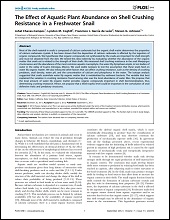The effect of aquatic plant abundance on shell crushing resistance in a freshwater snail
Resumen
"Most of the shell material in snails is composed of calcium carbonate but the organic shell matrix determines the properties of calcium carbonate crystals. It has been shown that the deposition of calcium carbonate is affected by the ingestion of organic compounds. We hypothesize that organic compounds not synthesized by the snails are important for shell strength and must be obtained from the diet. We tested this idea indirectly by evaluating whether the abundance of the organic matter that snails eat is related to the strength of their shells. We measured shell crushing resistance in the snail Mexipyrgus churinceanus and the abundance of the most common aquatic macrophyte, the water lily Nymphaea ampla, in ten bodies of water in the valley of Cuatro Cienegas, Mexico. We used stable isotopes to test the assumption that these snails feed on water lily organic matter. We also measured other factors that can affect crushing resistance, such as the density of crushing predators, snail density, water pH, and the concentration of calcium and phosphorus in the water. The isotope analysis suggested that snails assimilate water lily organic matter that is metabolized by sediment bacteria. The variable that best explained the variation in crushing resistance found among sites was the local abundance of water lilies. We propose that the local amount of water lily organic matter provides organic compounds important in shell biomineralization, thus determining crushing resistance. Hence, we propose that a third trophic level could be important in the coevolution of snail defensive traits and predatory structures."
Colecciones
Ítems relacionados
Mostrando ítems relacionados por Título, autor o materia.
-
PROMOCIÓN DEL PERIFITON PARA EL CULTIVO DE CAMARÓN BLANCO: HACIA UNA ACUICULTURA ECOLÓGICA
DOMENICO VOLTOLINA LOBINA; JUAN MANUEL AUDELO NARANJO; MARIA DEL ROSARIO PACHECO MARGES -
Suelo y Erosión
YOLANDA LOURDES MAYA DELGADO


